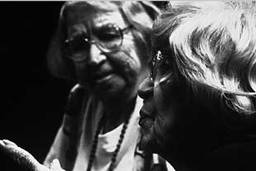
Alex Gibney’s Enron: The Smartest Guys in the Room is based on the eponymous book by Peter Elkind and Bethany McLean, the Fortune reporter who first alerted the lethargic financial press to the peculiar nature of Enron’s business model back in 2001. The authors appear in the movie, along with many more witnesses, victims, perpetrators and bystanders, some of whom appear in breathtakingly arrogant inside-Enron videos and audio recordings.
At its most unadorned, this would be a talking-heads story, but Gibney has dressed it in all the techniques of the moment, using everything from the animated type of “motion graphics” to the hyperkinetic editing of car commercials. A sometimes too-literal soundtrack aggressively punctuates the story. Gibney clearly thinks he has to fight for the viewer’s attention in order to explain Enron’s mind-numbing scams, and he sucessfully accomplishes that daunting task. Would you understand more about the Enron swindle if you read the book it was based on? Obviously, there is more factual detail in hundreds of pages. But there is a glittering impact in the accumulation of images and audio bursts packed into the movie’s short two hours.
And there are some deceptions a book cannot unravel as vividly as a film, such as the answer to narrator Peter Coyote’s question, “Who is M. Yass?” The name of an illusory participant in one Enron scheme, “M. Yass” appears in a close-up at the bottom of a document. The film then animates the ‘Y’ so that it slides left to join the ‘M,’ creating the answer: “MY ass.” Remember, these are the guys who named phantom partnerships after Star Wars characters.
The frat boys at Enron did do something illegal enough to warrant warrants and, eventually, convictions (although Ken Lay’s trial does not start until 2006), and even cost them some of their own millions. To put that in perspective: Lay bleats that his net worth was reduced to less than $20 million, with liquidity under a million. Let me brush away yet another tear of bitter laughter.
But do these prosecutions in any way support the assertion by the president and others that these were the proverbial bad apples, rather than an example of the way things are supposed to be, only super-sized? This is the most useful and enduring question about Enron.
The film repeatedly raises the “bad apple” thesis and then bats it down, usually with sarcasm. But it seems unable to muster the same clarity on this matter as on the airtight case it makes for Enron’s California electricity blitzkrieg. The film and book do painstakingly demonstrate that Enron’s intricate web of fraud was spun by not only the energy corporation and the late century-old accounting firm Arthur Andersen, but also the nation’s largest banks and stock brokerage firms, and of course that Sleeping Beauty, the acquiescent Securities and Exchange Commission. And let’s not forget those oblivious fellow travelers on television and in trade magazines who seemed to believe anything they were told.
The film goes to great lengths to hang the story on personalities (a modern media imperative) and so it is necessarily a bit hard to see the system that produced them. But Gibney wisely returns at the end of the film to point the way to understanding Enron by offering up Enron’s own contemptuously hypocritical corporate slogan: “Ask Why.”
To answer that question would require an additional movie, one that can explain the significance of Enron’s fall and why the thud crushed millions of the not-rich while only grazing the super-rich. That movie would demonstrate why, ultimately, American capitalism had to find a way to prosecute the Enron boys, not for being financial mobsters (although this is organized crime if ever there was any), but because they did something akin to spilling the secrets of the Skull and Bones — their ruthlessness made the nucleus of corporate capitalism all too obvious.
To understand that, the film required is last year’s The Corporation, which has just come out on DVD with lots of extras. Gibney’s film is the definitive case study underscoring The Corporation’s excellent analysis of the pitiless history and philosophy that made Enron possible, indeed inevitable.






